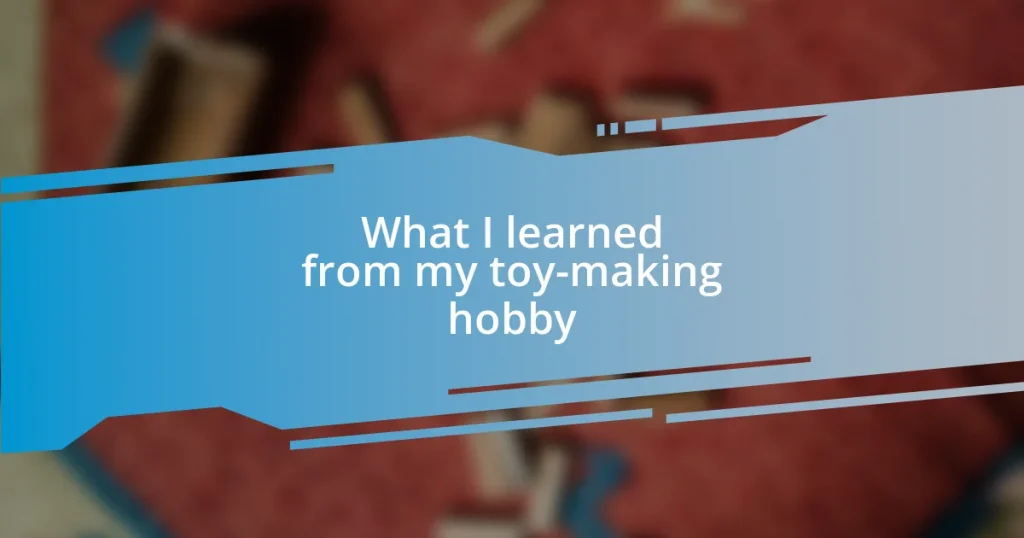Key takeaways:
- Essential tools for prop crafting include a utility knife, precision scissors, a hot glue gun, and a cutting mat to ensure precision and durability.
- Understanding materials like foam, wood, plastic, and fabric is crucial for creating effective and resilient props that fit the project’s narrative.
- When showcasing props, effective presentation, engaging with communities, and utilizing social media enhance visibility and appreciation of your work.

Essential Tools for Prop Crafting
When it comes to prop crafting, having the right tools can make all the difference. I remember my first attempt at creating a realistic set piece; I relied on just a few basic tools. It was a struggle! I quickly learned that a good utility knife and a set of precision scissors are essential—these tools allow for clean cuts that transform your ideas into tangible creations.
I can’t stress enough the importance of a quality hot glue gun. The satisfying ‘squelch’ as you press the glue and hear it secure a piece in place is one of those joys of crafting. Plus, the versatility of a hot glue gun bridges various materials, whether you’re working with foam, fabric, or plastic. Have you ever had a project fall apart at the last minute? Having that dependable gun on hand can be a lifesaver, ensuring your hard work stays intact.
Lastly, let’s talk about a cutting mat. While it may seem like a simple tool, it acts as a protective layer for your workspace while ensuring precision. I once ruined an old coffee table during a late-night crafting binge, which taught me the hard way that a cutting mat is non-negotiable! How do you protect your crafting surface? Investing in this simple tool can save you from future disasters and enhance your overall crafting experience.

Understanding Different Materials
Understanding the materials you choose is vital in prop crafting. I’ve encountered everything from lightweight foam to dense wood, and each material lends a unique property to the final product. For instance, while foam is fantastic for achieving a lightweight and versatile prop, using wood can add durability, making it ideal for pieces that need to withstand the test of time or wear. One time, I decided to mix materials for a project, using foam for the body and wood for the base. It created a striking visual contrast while maintaining functionality—an approach I highly recommend exploring.
Here’s a quick overview of common materials and their distinct characteristics:
- Foam: Lightweight, easy to shape, and paintable; great for creating large props.
- Wood: Offers durability and sturdiness; perfect for bases or detailed craftsmanship.
- Plastic: Versatile and weather-resistant; useful for props that might be exposed to the elements.
- Fabric: Provides texture and movement; ideal for costumes or soft props.
- Cardboard: Inexpensive and easily accessible; excellent for prototyping or one-off designs.
- Resin: Great for creating detailed and hard casts; suitable for intricate designs and long-lasting results.
Understanding these materials is an empowering step in your crafting journey, allowing you to make informed choices that elevate your props to the next level. Finding the right blend can truly bring your vision to life!

Designing Effective Prop Concepts
Designing effective prop concepts begins with a solid understanding of your project’s needs. I’ve often found myself brainstorming ideas driven by the story rather than just the visuals. For instance, when designing a magical artifact for a fantasy play, I thought deeply about its backstory—what it represented, how it would feel in the hands of the actors. That connection to the narrative made the prop feel more authentic and engaging. Have you ever crafted something that truly embodies the essence of a story? It’s a rewarding experience when the prop feels like a character in itself.
Another essential aspect is considering the prop’s functionality. I vividly recall a time when I created a sword for a short film, opting for a lightweight material so it wouldn’t hinder movement. It was crucial to balance realism and practicality; the sword looked impressive on screen, yet it was easy for the actor to wield. Thinking about how the prop interacts with its environment and the performers transforms a simple concept into something that enhances the entire production.
Lastly, don’t underestimate the power of visual references. I often gather images that inspire me, compiling them into a mood board. It’s fascinating how a single image can spark an idea or transform a concept. During the design process for a sci-fi gadget, I stumbled upon a photo of an old camera, which inspired me to incorporate a vintage look. This led to a unique blend of old and new, making the final prop stand out. Drawing inspiration from various sources can help you break the mold and create something truly distinctive.
| Design Aspect | Importance |
|---|---|
| Understanding Story | Crafting props that resonate with the narrative enhances engagement. |
| Functionality | Ensures the prop is practical for its intended use, avoiding distractions. |
| Visual References | Inspires creativity and innovation, leading to unique designs. |

Step by Step Crafting Techniques
When it comes to step-by-step crafting techniques, I often start with sketching my ideas. Recently, I found that putting pencil to paper not only gives me a visual plan but also helps me mentally walk through the entire process. By detailing each part, I can anticipate potential challenges. Have you ever had a project go awry simply because you didn’t foresee a complication? Trust me; a little planning goes a long way.
Next, I always prepare my workspace. It’s surprising how much a tidy area can influence your creativity. When I first started crafting, my workspace resembled a chaotic art studio, overflowing with materials. However, after organizing my tools and supplies neatly, I noticed an immediate boost in my productivity and focus. Keeping your area clutter-free can enhance your crafting experience and minimize distractions—something I can personally vouch for!
Lastly, I recommend breaking the crafting process into manageable steps. Instead of attempting to complete a prop in one go, I tackle it section by section. For example, while creating a helmet for a cosplay event, I focused on shaping and painting the exterior first. Once that was done, I moved on to the lining and details. This approach not only makes the project feel less daunting but also allows you to celebrate small victories along the way. Isn’t there something deeply satisfying about completing a part of your project? Each step brings you closer to the final masterpiece!

Painting and Finishing Props
A crucial step in painting props is choosing the right type of paint. I always opt for acrylics when working on detailed pieces, as they dry quickly and offer vibrant colors. Once, while crafting a steampunk device, I applied a metallic spray and was shocked by how it transformed the piece—it felt like I had breathed life into it! Have you ever had a moment where the right paint just made everything click? It’s a reminder that paint can truly enhance the character of a prop.
After the base layer is complete, I focus on adding depth with highlights and shadows. I often find it exciting to watch a flat surface gain dimension through simple techniques like dry brushing or washes. For instance, while painting a weathered book for a theatrical scene, I mixed a little brown paint with water and brushed it over the surface, allowing it to seep into the crevices. The difference was astounding, giving the book an aged, storied look that complemented the narrative beautifully. It’s fascinating how these layering techniques can evoke emotions and transport you into the world of the prop.
Finishing touches are equally important, and I always seal my painted props with a protective finish. A matte or gloss varnish can dramatically alter the final appearance and durability. I remember finishing a faux leather bag for a character costume; once sealed, it felt new and rugged at the same time. Do you consider sealing as the final magic touch in your projects? I believe it signifies completion, reflecting all the effort put into the creation. Ultimately, these steps not only enhance the visual appeal but also ensure longevity, allowing the props to be cherished for years to come.

Tips for Prop Durability
When it comes to keeping my props in tip-top shape, I always think about material selection first. For example, I once crafted a sword using lightweight wood instead of heavier materials, which not only made it easier to handle but also increased its durability. Have you ever noticed how some props just seem to last longer than others? I believe it’s all about making the right choices from the beginning.
Another tip I swear by is reinforcing the structure of my props. I remember when I created a large, intricate dragon wing for a costume. Instead of relying solely on fabric, I added wire supports within the wings. This simple addition allowed them to maintain their shape while being resilient enough to withstand the wear and tear of a busy event. Isn’t it amazing how a little support can extend the life of a project?
Lastly, maintaining your props after creation is critical. I tend to store my items in climate-controlled conditions to protect them from moisture and temperature fluctuations. Not long ago, I found an old prop in my attic that had become brittle due to extreme temperatures. It was heartbreaking to see my hard work deteriorate! So, let me ask you—how do you preserve your beloved creations? For me, safe storage is key to ensuring that my props remain as stunning as the day I finished them.

Showcasing Your Finished Props
When it comes to showcasing my finished props, presentation makes all the difference. I still remember the first time I displayed a meticulously crafted goblet at a convention. I placed it on a velvet cloth, and the way it shimmered under the lights turned heads and drew people in. Isn’t it incredible how a simple backdrop can elevate the perceived value of your work?
Social media has become a powerful tool for showcasing our creations. I often share photos of my props in different settings, which allows others to see them in action. A recent post of mine featured a detailed sci-fi helmet surrounded by LED lights, and the response was overwhelmingly positive. The excitement that builds when others appreciate your work is simply exhilarating, don’t you think?
Engaging with fellow enthusiasts is another rewarding aspect of showcasing my props. I recall a time when I participated in a local exhibit, and seeing people’s faces light up as they interacted with my creations was priceless. That personal connection can foster a supportive community, inspiring further creativity. How do you share your work? For me, it’s all about building relationships while celebrating our passion for crafting.
















